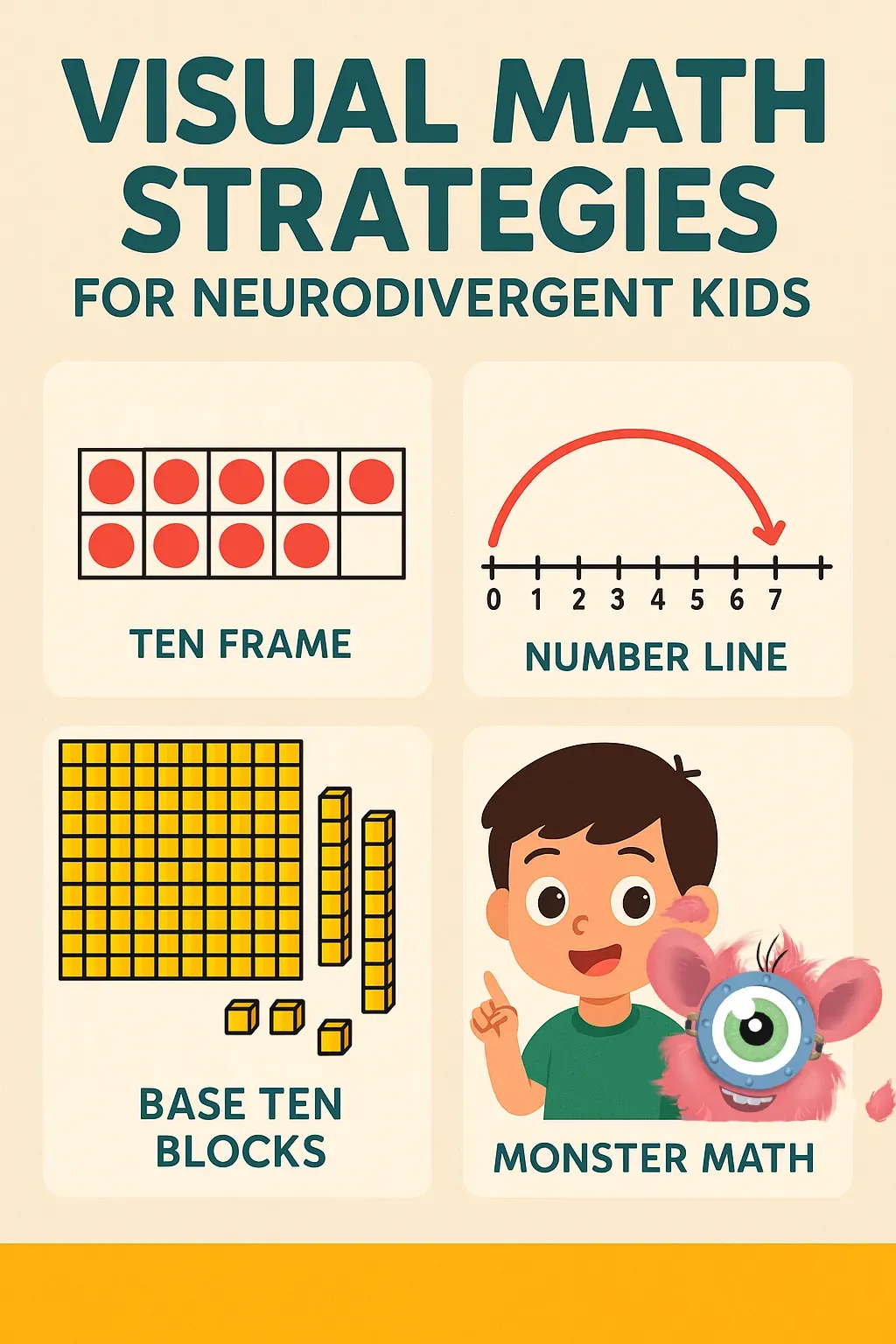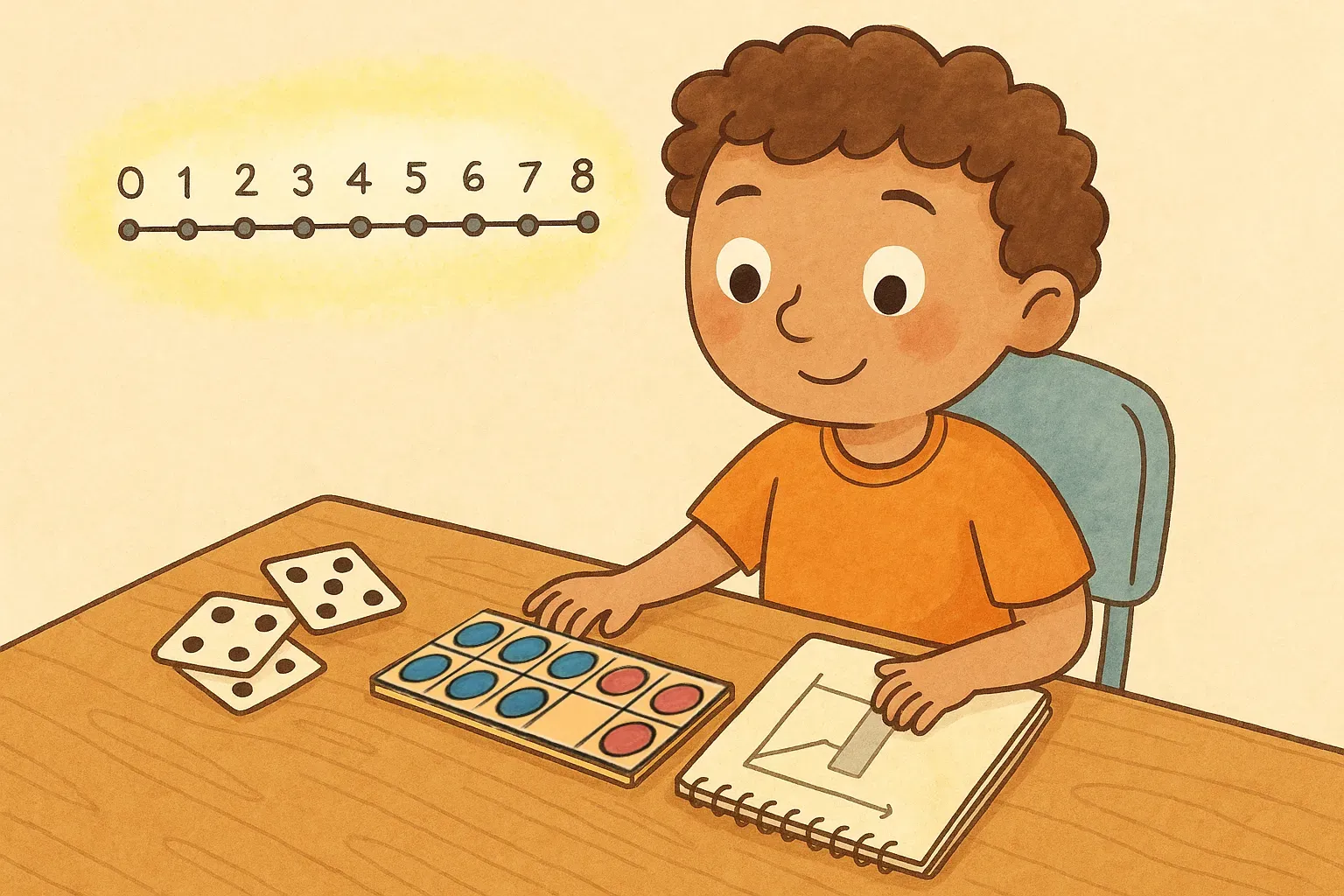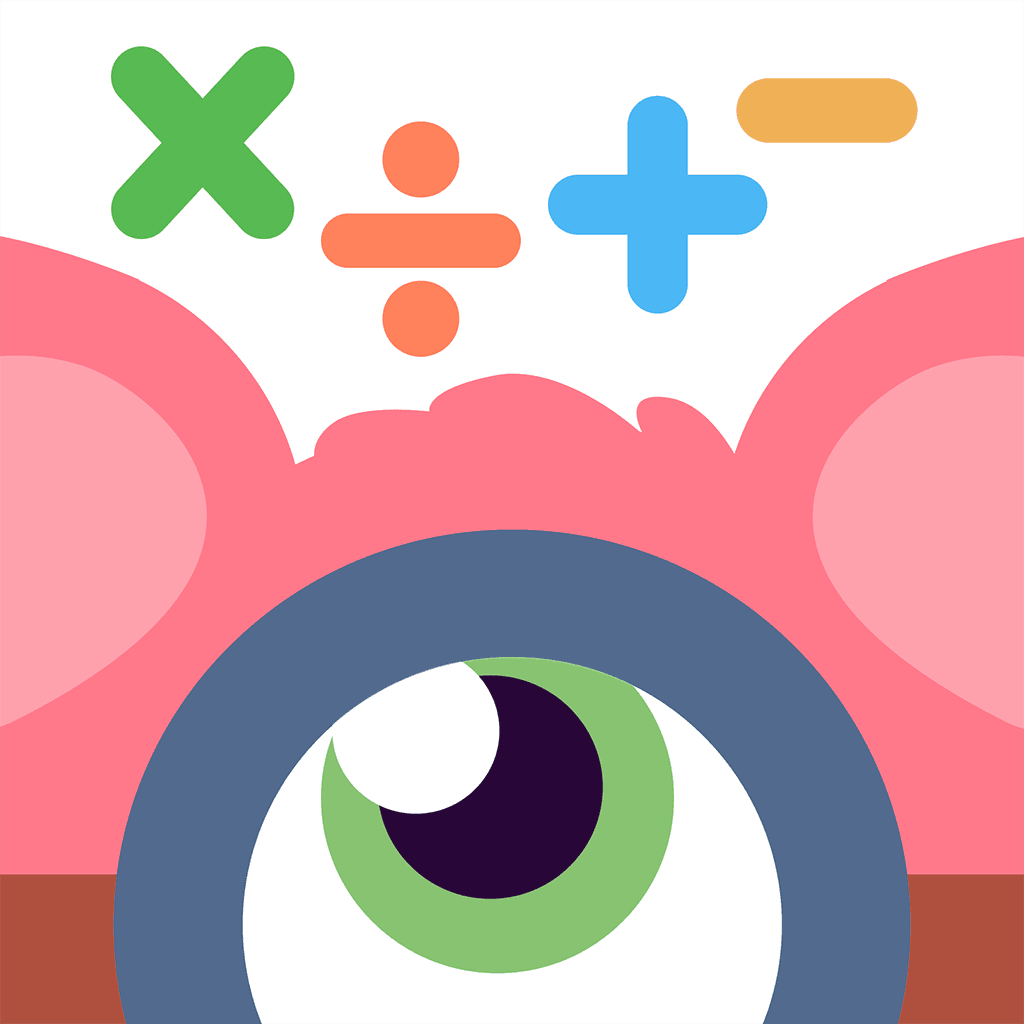Visual Math Strategies That Actually Work for Neurodivergent Kids
Why Visual Strategies Matter for Neurodivergent Learners
Children with ADHD, autism, dyscalculia or executive-function delays often struggle in traditional math settings. Studies link ADHD math difficulties more to working memory and attention issues than to any innate “number sense” problem. In fact, one recent trial found visualization techniques significantly improved word-problem solving for kids with ADHD, helping them break down problems into pictures or diagrams.
In dyscalculia, children rely heavily on concrete, visual counting aids; without these, even basic number concepts remain unclear. Autistic children often process information visually, and many excel at recognizing dot patterns (“subitizing”). In short, seeing math – through images, objects, or steps – can make numbers click for neurodiverse kids. These strategies harness strengths like visual-spatial reasoning and pattern recognition, and they lighten cognitive load by giving the brain something concrete to focus on.

Key Visual Strategies for Math
Number Lines: Making Counting Concrete
A simple number line (a line marked with 0, 1, 2, …) lets kids physically “jump” through problems. For example, to solve 5+3, your child can start at 5 on the line and make 3 hops forward. Research shows that guided use of number lines (often with markers or physical manipulatives) builds number sense and fluency. One intensive tutoring program taught addition facts using manipulatives and a number line, gradually introducing +1, –1 and then bigger steps. It found students learned counting-up strategies effectively by “starting with the larger number and counting on the smaller number on fingers or a number line”
In practice, draw a number line on paper or use a string on the floor. Encourage children to count out loud as they move a token. Color-code sections (e.g. 0–10 one color, 10–20 another) to reinforce place value.
Note: many children with math learning difficulties initially misplace numbers on an imagined number line, so start with a large, clear line (or physical track) and practice placing numbers accurately.
Ten-Frames and Dot Patterns: Building Number Sense
Ten-frames (2×5 boxes) and dot cards show numbers as familiar patterns. Laying 7 counters on a ten-frame immediately shows “5+2” by filling one row and two in the next. Dot cards (like the dots on dice or dominoes) leverage pattern recognition.
This matters: research on dyscalculia finds subitizing (instantly seeing “4” on a dice face) is hard for some kids because they struggle with dot-pattern recognition.
Repeated practice with common arrangements (5 in an ‘X’ shape, 4 in a square, etc.) can train this skill. In fact, autistic students often excel at subitizing during early grades, so games with dice and dot cards play to their strength.
To use these tools, play games where the child names the dots without counting. Show how numbers split into parts: e.g. 8 dots can be “5 and 3” by filling a ten-frame to 5 and then 3 more. This concrete breakdown helps kids see number relationships.
This concrete breakdown helps kids see number relationships. The Child Mind Institute notes that struggling math learners frequently depend on visual aids like fingers to count – ten-frames and dot cards are just more precise, durable aids to build that same support.
Visual Problem Breakdown: Pictures, Charts and Diagrams
Multi-step word problems can overload executive function. The key is showing the steps. Encourage your child to draw the problem: sketch objects, charts or bars that represent each part of the question.
In a recent controlled trial, children with ADHD who were taught to draw (or use pre-drawn images) for word problems improved dramatically.
Likewise, a large study found that third-graders with math difficulties performed significantly better when they used visual strategies (placing numbers in diagrams) versus just verbal hints. For example, turn a story problem like “Maria had 3 apples and picked 4 more” into a picture of 3 apples then 4 apples.
Flowcharts or stacked boxes can also break a problem into ordered steps. Graphic organizers (e.g. a box for “what do we know?”) provide anchors so kids don’t have to hold all the info in memory.
Simple charts or step-by-step visuals help ALL neurodiverse learners: for instance, writing the sequence 1) draw picture, 2) write numbers, 3) compute answer keeps children focused. One practical tip is using whiteboards or large paper – having a big space means their sketch doesn’t get erased by the next step.
Color-coding operations (e.g. green for addition, red for subtraction) can further clarify the process.
Manipulatives and Hands-on Tools
Physical objects (counters, blocks, beads, Cuisenaire rods) are classic tools in special education—and for good reason. They make numbers touchable. Many curricula for math disabilities emphasize manipulatives alongside visuals.
For example, using base-10 blocks to represent tens and ones turns abstract regrouping into a moving puzzle.
When teaching an operation, let your child physically group or ungroup items. Say, to solve 12–5, take 12 blocks, remove 5, and count what remains. This concrete manipulation doubles as a visual; you see the quantities change. Additionally, colorful arrays (like dots in a ten-frame) or tactile charts can reinforce counting by fives or tens. Even simple items (coins, buttons, legos) serve as number models when nothing else is at hand.
Putting It Into Practice: Tips for Parents
- Make it routine: Have a consistent math time with a visible schedule (e.g. a checklist or bulletin board showing “1. Warm-up, 2. Practice, 3. Game”). Predictability reduces overwhelm.
- Game-ify learning: Turn facts into play: use dice games, matching cards, or counting songs. For dot patterns, play “flash” (briefly show a domino). Ten-frame bingo or counting bead activities can be fun.
- One step at a time: Break every problem into micro-steps. After each step, have your child say or write down what they did (“moved from 5 to 6”), then check before moving on. Celebrate each mini-success to build confidence.
- Use multi-sensory cues: Speak math as you write or act it out. “We add three now, see the jump on the number line?” Hearing the strategy name while seeing the action links them.
- Limit distractions: Especially for ADHD or EF issues, provide a quiet, well-lit space. Fidgets or a wobble cushion can help some kids focus. (Research notes reducing sensory stress frees up working memory.)
- Be patient and positive: If the child gets stuck, gently guide (e.g. “Let’s draw it together”) rather than giving the answer. The goal is building understanding, not speed.

FAQs
What is a ten-frame and how do I use it?
A ten-frame is a 2×5 grid. You fill it with counters to visualize numbers up to 10. For example, 7 would fill one row (5) plus 2 in the next. This helps kids see groupings of 5 and 10 without counting each dot. You can draw ten-frames on paper or buy a plastic board with slots.
How do number lines help my child?
Number lines show numbers in order on a line. They let kids “jump” forward/backward to add or subtract. This makes addition/subtraction a spatial activity. Research programs for math disabilities have successfully taught facts by moving on number lines. It’s especially helpful for bridging (e.g. going from 9 to 10 then to 12 in 9+3). Use real or drawn lines, and always mark the starting number before counting.
What are dot cards and why use them?
Dot cards show a number of dots in a fixed pattern (like faces of a die or dominos). They train subitizing – the ability to recognize quantity at a glance. Dyscalculic kids often struggle to instantly recognize dot patterns, so practicing with standard layouts (4 in a square, 6 as two rows of 3, etc.) helps. Play by flashing the card and having your child say the number. Over time they’ll “see” the number without counting one by one.
My child freezes on word problems. How can visuals help?
Freezing often means the brain is overwhelmed by steps. Encourage your child to draw their own picture of the scenario (even stick figures). Alternatively, use graphic organizers: e.g. have two boxes labeled “what do we know?” and “what do we need?”. Research shows that teaching kids to use their own drawings or provided diagrams significantly improves word-problem accuracy. It externalizes the information, so the child isn’t trying to juggle words and numbers only in their head.
Where can I find good materials or worksheets?
Look for resources from special-ed math programs or university websites. You can also repurpose household items (coins for counters, tape on the floor for number lines). For apps or games, seek ones with built-in visuals rather than rote drills.
Further Resources
Why Your ADHD Child Freezes at Math
How to Build Number Sense in Kids with Dyscalculia
Math Routines That Support Autistic Kids
Time Management for Neurodivergent Kids
Learn More
For a comprehensive guide, explore our comprehensive article -
Neurodivergent Math Learning Strategies That Actually Work for Your Child

